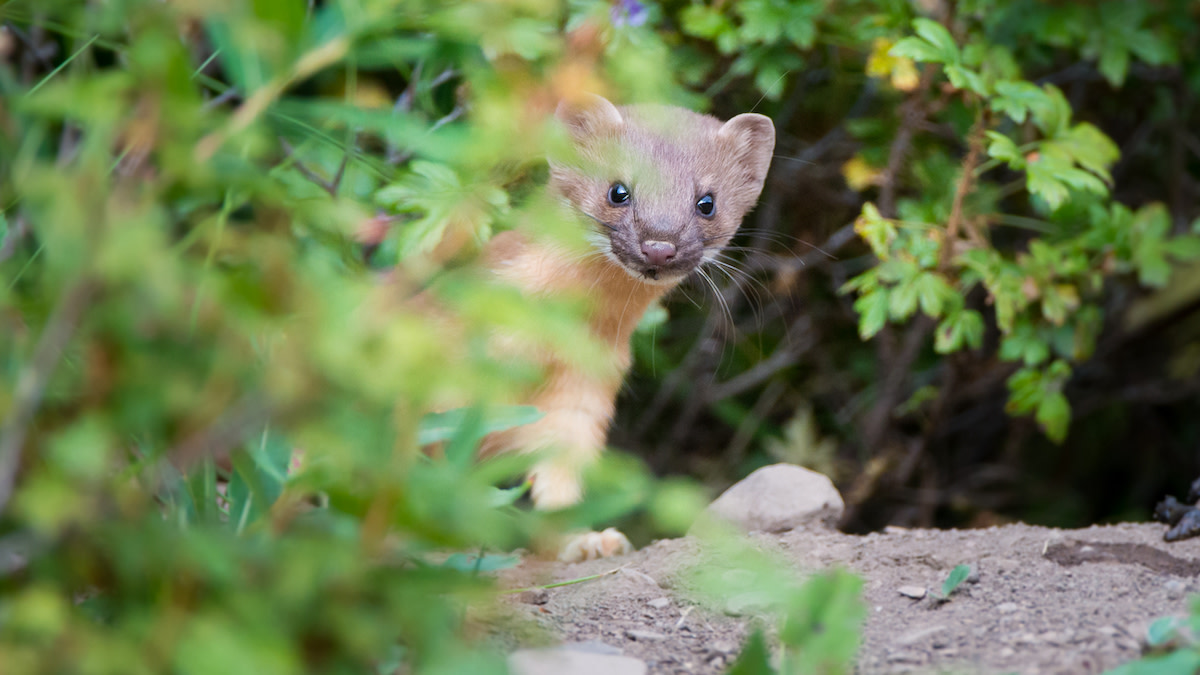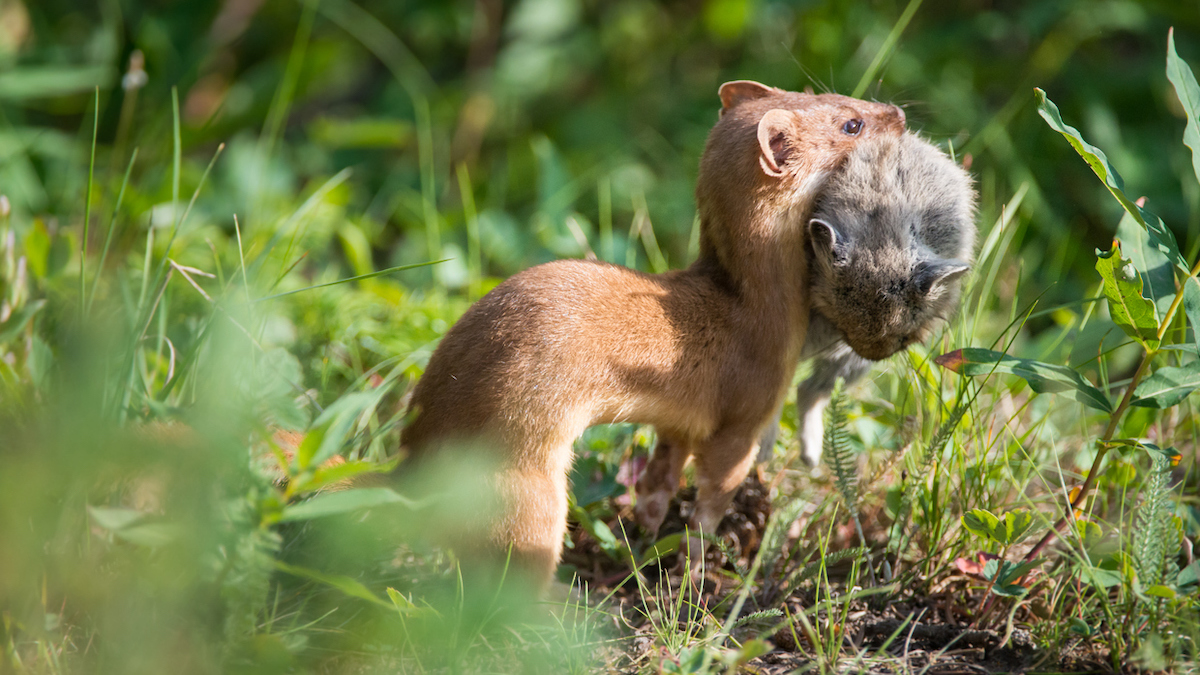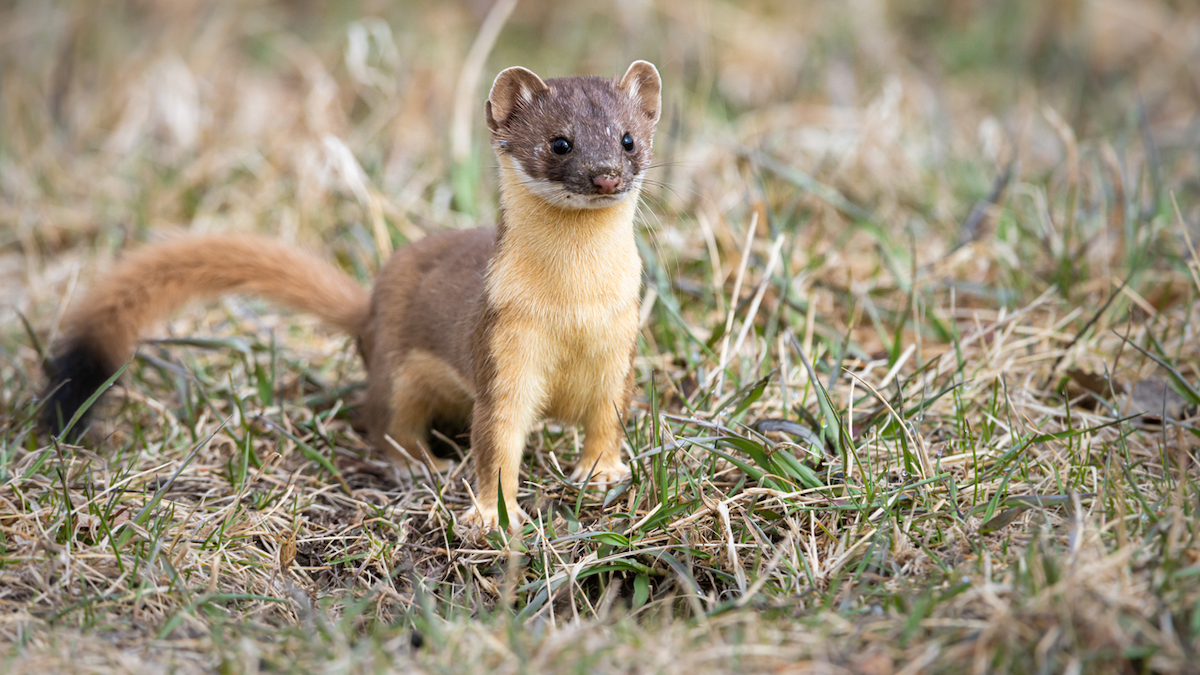
The weasel on my office desk has a serpentine body that wraps into a tight coil. It’s perched on a piece of driftwood and has lush chocolate brown fur that melds into a porcelain white belly. It has a cheese wedge head, stubby legs, and a black-tipped tail the length of a butter knife. My old man trapped that weasel in a 110 conibear set on a muskrat run back in the ‘80s. Often, as I write, I catch myself gazing at its beady eyes.
Growing up, I’d admire that piece of taxidermy as if it were on display at the Museum of Modern Art. For a while, I thought it was a mink. I saw plenty of those while duck hunting and fishing on the southern New Jersey salt marsh. I think the confusion began to annoy my dad because he started correcting me until it stuck. That was no mink, I came to learn, but every time I went out to nab a weasel of my own, I turned up empty-handed.
When I told that story to Dr. David Jachowski, Associate Professor of Wildlife Ecology at Clemson University, he wasn't surprised.
“Avid outdoorsmen and women have seen lots of things in their lifetime,” he said, “and then you have species like weasels. It's kind of like seeing a mountain lion. We know they're out there, and you might see them, but they’re pretty cryptic.”
Dr. Jachowski has a soft spot for small, imperiled mammals. Early in his career, he dedicated 10 years to the U.S. Fish and Wildlife Service working on a black-footed ferret recovery program. Then, he published a book about their plight in 2014. From black-footed ferrets, he transitioned into research with the eastern spotted skunk, a cousin to the common striped skunk and a tiny carnivore that’s experienced over 90% population declines across its patchwork range. He helped establish the Eastern Spotted Skunk Cooperative Study Group and has mentored graduate students researching spotted skunk population ecology at Clemson. Now, his sights are set on weasels.
In 2021, Dr. Jachowski and his colleagues published their paper, Tracking Decline of Weasels in North America. Scraping together sparse datasets from four unlikely sources, and using a novel approach to combine that data, Jachowski and his team uncovered an ecological plight that will likely guide the next chapter of his career. Weasel populations across North America have been declining for decades, and now wildlife managers and researchers are scrambling to figure out why.

Weasel 101
Three species of weasel exist in North America: the long-tailed, short-tailed, and least.
Long-tailed weasels, like the one my dad trapped, are the most common. They range from Bolivia to Southern Canada and are typically about a foot long. You can distinguish short-tailed weasels from long-tailed weasels by the size and the length of—wait for it—their tails. The short-tailed weasel is smaller and the tail is about one-third of its body length. The tail of the long-tailed is about half its body length. The least weasel is the smallest of the three. They are only about the length of your fully extended hand, which makes them the world’s smallest mammalian carnivore. You can find least weasels in Alaska, the Great Lakes region, and down into the southern Appalachians.
It’s important to cover some weasel basics because odds are, you’ve never even seen one. They operate under the cover of grassy fields, hedgerows, and rotting wood piles, where they consume anywhere from 20% to 50% of their bodyweight per day. For a 180-pound human, that’s like eating two of those 45-pound plates you see threaded on barbells at the gym worth of food. If you ever found a weasel snacking on a meadow vole, you’d notice its teeth. Weasels kill their prey by clamping down on the nape of their neck, and their teeth pierce into vertebrae like needles.
Weasels also engage in what biologists call surplus killing. They kill what they need to eat and more, caching excess carcasses in the way we fill up our food pantries. They adapted this behavior as a survival strategy for days when the hunting gets tough. For a long time, farmers considered weasels as nothing more than chicken killers, but weasels also kill the rodents that contribute to crop damage. In the weasel pantry, you’ll find small mammals like shrews, voles, and mice. These species commonly feed on herbaceous plants, roots, tubers, and other young vegetation. Recent research suggests that when weasels predate on small mammal communities they allow all that vegetation to grow. In that regard, weasels may even regulate the forest and plant communities around them.
John C. Ewers, American anthropologist and ethnologist, hypothesized that the weasel’s predatory prowess was in part why the Native Americans of the Great Plains revered them so much. Weasel pelts decorated chief bonnets and warriors’ clothing. Warriors fastened whole carcasses to rawhide shields as a symbol of good medicine. They even sculpted weasel effigies into the rims of their war clubs.
Plains tribes constructed weasel traps by arranging willow branches into a compact tunnel. They baited the trap with fresh meat. To get to the bait, a weasel had to enter the tunnel and fight through a series of snares that were fashioned out of sinew and sometimes horsehair. Today’s trappers mimic that method through what they call a cubby set. Trappers construct a rectangular box out of old or weathered lumber. They drill a hole in either end, just big enough for a weasel to fit through, and place some bait inside along with a foothold or body-gripping trap.
Case skinned weasels sold for $1.17 a pelt in British Columbia during the Roaring Twenties. Adjusted for inflation, that’s $13.50 a pelt. If I stripped the fur from my dad’s taxidermied weasel and sold it at a fur auction today, I’d be looking at as little as a dollar.
That can explain, in part, why there aren’t many people out trapping weasels. It can’t explain, however, the results of Dr. Jachowski’s research.

A Quiet Demise
When weasel harvests started slipping in the early 2000s, few people took note except for a handful of fur trappers and the wildlife biologists managing their harvest reports. Dr. Jachowski and his colleagues compiled these reports from 46 states and 12 Canadian provinces. They discovered that since the 1960s, annual weasel harvests have declined anywhere from 87% to 94%.
Pelt prices usually drive fur trapper effort, and since fur clothing has fallen out of favor over the last century, so too has the number of people out trapping. Ostensibly, this could explain the decline in weasel harvest. The logic follows that with less people trapping them, there will be less weasels caught. But when Dr. Jachowski and his colleagues accounted for trapper effort in their statistical models, they found that the decrease in weasel harvest outpaced what would be expected from the decrease in trappers. His team also looked at the influence of falling pelt prices, but the result was the same. Both low trapper effort and diminished pelt prices failed to explain why weasel harvests have dropped so low.
To find out what might be going on, they tacked on additional datasets. They collected citizen science reports from the popular social networking app iNaturalist. iNaturalist allows users to share observations of plants and animals from around the world. As of 2020, the app had over 1,000,000 observers uploading 89,000 species reports a month. They also examined museum inventory records and data collected from a nationwide collaborative trail camera network called Snapshot USA.
Nearly 89% of records came from before the year 2000. Museum inventories suggested that the distribution of least weasels has been severed in two, separated by a 1,000-kilometer gap. iNaturalist data exposed the disappearance of weasels in regions where they were once abundant, and despite 53,505 trail camera nights' worth of data, spread across 12 ecoregions and 1,509 sites, weasel photos were scarce, and only occurred above 40 degrees latitude.
With volumes of data in front of them, and the statistical analyses to back it up, the trend became clear. Weasel populations have been plummeting since the early 2000s.

Shifting Perspectives
Dr. Jachowski’s study identified the decline and now the challenge will be to determine the causes. His paper proposes several potential reasons.
Shifting land-use practices, specifically the transition from small family farms to industrial row crop agriculture, has altered weasel habitats and disturbed the population dynamics of their prey. Row crop agriculture also comes with rodenticides. Dr. Jachowski conducts research on a barrier island off the coast of South Carolina, where multiple bobcat deaths had been attributed to secondary exposure to rodenticides. He said that rodenticides have even been found in fisher and otter populations in New York. Since weasels eat so many rodents, they are particularly susceptible to poison.
Weasels may also suffer from an evolutionary mismatch. Ever wonder why we grow wisdom teeth, just to have some dentist butcher your gums and carve them out? That’s an evolutionary mismatch. Wisdom teeth served a purpose for our ancestors, who had bigger jaws and ate tougher food than we do. As our jaws shrank, our wisdom teeth stuck, and now we need to pry them out. All three North American weasels turn snowy-white in the winter. Historically, it was a clever product of evolution that allowed them to adapt to seasonal landscape changes. Habitats may receive less snow cover as our climate warms, and on a snowless winter day, a white weasel sticks out in a grassy field like a sock in the middle of your living room. This not only opens them up to predation but also ruins their hunts.
Dr. Jachowski suggests that weasels may have also suffered from disease outbreaks, such as canine distemper or sylvatic plague, increased predation by owls and raptors, and historical overharvest by trappers. Whatever the case may be, his paper calls for a unified effort to understand the phenomenon. But due to their cryptic nature, weasels are hard to find, and that’s one of the biggest challenges for biologists managing weasel populations.
For example, the last two decades have seen a revolution in the way we survey for weasels, and many of these new techniques highlight the creativity of wildlife researchers. Methods include trail cameras in modified cubby sets, baited track plates covered in chalk or soot, baited sticks rigged with barbed wire to collect hair samples, and scat-sniffing dogs. These state-of-the-art methodologies show promise, but the likelihood of detecting weasels, even if they’re there, remains consistently low, usually somewhere below 20%.
To recover weasel populations, the issue of inadequate survey techniques will need to be addressed. “The next challenge is to have a dedicated approach to monitoring weasels that provides similar data across states that can be repeated through time.” Dr. Jachowski said. As for the current survey methods, Dr. Jachowski says they need to be improved.
Dr. Jachowski also emphasized the role of the general public.
“Citizen science is critical,” he said, “As wildlife biologists, we can’t look everywhere, but there are people everywhere.” He suggests that citizen science may serve as a foundation to redraw the range map for the least weasel, whose historic distribution maps do not reflect the 1000-kilometer gap found in Dr. Jachowski’s study. “So, if we can get word out that we’re looking for reported sightings, we can start to narrow in on what we do and fill in those range maps, which are really important.”
This past year, Dr. Jachowski joined representatives from 16 states and 11 universities in the first-ever Weasel Working Group meeting. He modeled the group in the same successful framework as the Eastern Spotted Skunk Cooperative Study Group. Together, the new coalition joined in a mission to develop weasel research, enhance survey protocols, and increase communication among managers and researchers. While there is no clear path towards weasel recovery yet, Dr. Jachowski remains hopeful. In his eyes, sparks create flames.
“The best thing that came out of this paper is the conversation,” Jachowski asserted. “We can make a lot of progress by just collaborating together. People rally around it once we find issues like this. We can learn a lot, advance science, and advance conservation really quickly just from working together.”






Conversation